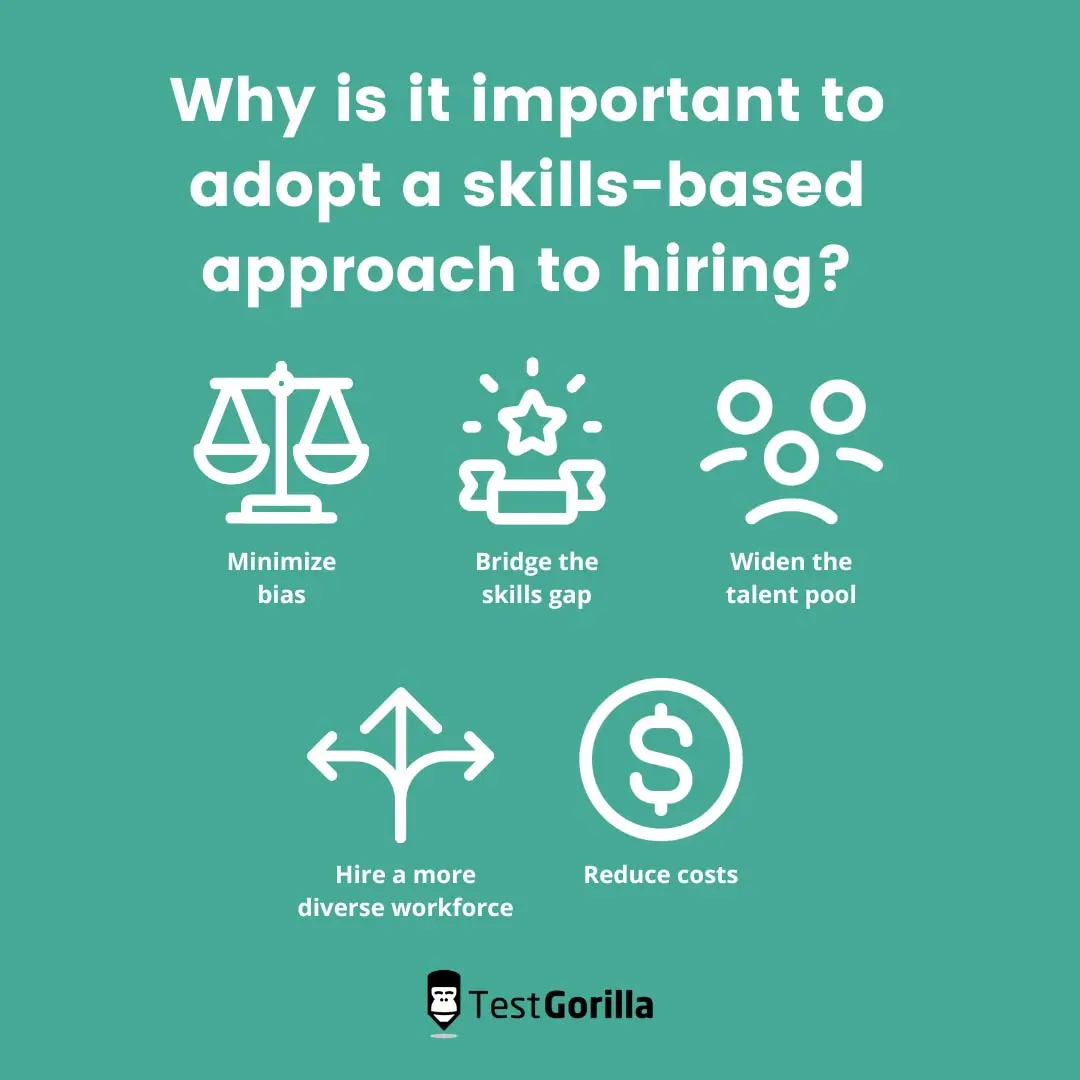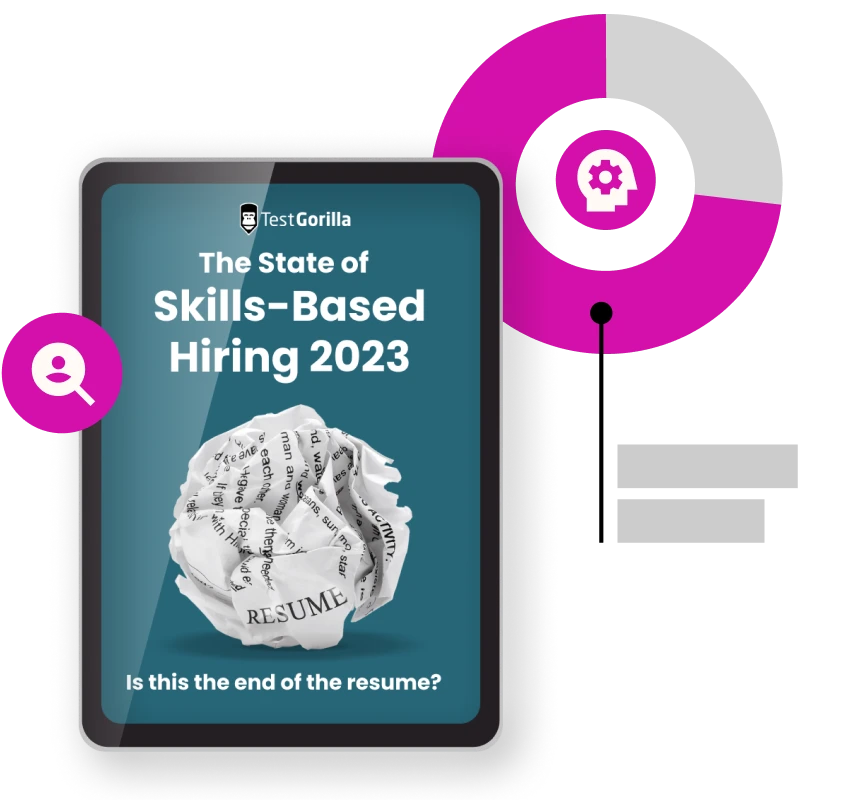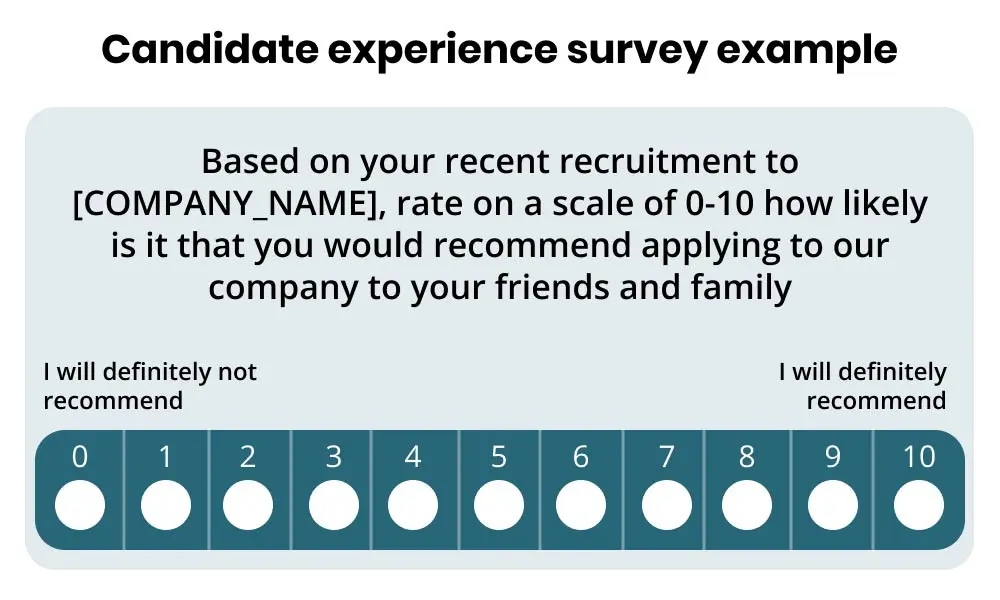A good hiring process helps you attract and secure the best candidates for your open roles, but traditional methods just aren’t cutting it anymore – 87% of employers are having difficulties with resumes, although 82% still use them to hire.
In this blog, you'll find 11 best hiring practices to follow so you can identify skills and start filling positions effectively and efficiently.
Table of contents
Why is best practice important for recruiting?
Best practices for recruiting are procedures, actions, and strategies that are demonstrated to lead to the best hiring outcomes. Best practices are important in recruitment for several reasons:
They ensure hiring practices are fair. Referring to hiring best practices helps employers design hiring processes that mitigate bias and give every candidate a fair shot.
They keep time and cost-to-hire down. Best practices can help minimize the time and resources spent on hiring.
They minimize selection errors. This also saves time and money by reducing the chance of mis-hires.
Without further ado, here are 11 best hiring practices.
Improve your recruitment strategy with these 11 best hiring practices
About to start a big hiring push and need to know best hiring practices quickly? Here’s a short summary:
Best hiring practices for managers | Example actions |
1. Use skills-based hiring methods | Replace resume screening with pre-interview assessments |
2. Build a strong employer brand | Summarize your employee value proposition in your recruitment marketing |
3. Conduct a skills gap analysis | Survey team leaders to assess the most important skills in their teams, then use skills testing to measure the presence of those skills and note gaps to hire for |
4. Write skills-based job descriptions | Include a “responsibilities” section instead of a “requirements” section so you don’t exclude people without college degrees |
5. Offer competitive compensation and benefits | If you can’t give a high salary, make your offer more competitive by offering nontraditional benefits like flexible work |
6. Use employee referral programs | Allow everyone in the company to make referrals, not just your target team |
7. Test candidates for motivation and culture add | Use motivation and culture-add assessments alongside hard skills tests |
8. Use structured interviews | Ask all candidates the same questions in the same order |
9. Communicate proactively with candidates | Use candidate relationship management software to send automated update emails to applicants |
10. Begin onboarding immediately | Send new hires a personalized welcome from their team as soon as possible |
11. Collect feedback from all candidates – even unsuccessful ones | Send out surveys to collect feedback and use the results to fine-tune your recruitment process |
Keep reading for an in-depth exploration of each best hiring practice.
1. Use skills-based hiring methods
Skills-based hiring is one of the most effective best practices in hiring. It refers to the process of screening and recruiting job candidates based on skills, and using talent assessment scores, rather than education and experience, to make hiring decisions.
A potential candidate could have skills that are directly applicable to the role, even if they may not have the kind of formal qualifications employers are typically looking for. The easiest way to find out about a candidate's skillset is to send them a skills-based talent assessment.
Using skills-based best practices in hiring brings a wealth of benefits, such as:
Minimizing bias by basing hiring decisions on objective skills data. One study of more than 2000 job applications showed that the number of women hired into senior roles increased by almost 70% when skills-based methods were used.
Widening your talent pool. Many candidates with the right skills may not meet traditional degree requirements because they are STARs, or “skilled through alternative routes.”
Hiring a more diverse workforce. Professionals from many marginalized groups don’t have formal qualifications, so eliminating credentials from the hiring process improves company DEI; this also opens up opportunities for minorities and those with disabilities.
Reducing costs. Finding top candidates faster reduces the cost of hiring, onboarding, and training for each role. In fact, 74% of organizations saw a reduction in cost-to-hire after switching to skills-based methods.
The use of skills-based best practices in hiring is on the rise for good reason, but that doesn’t mean all degrees are irrelevant. Some qualifications are required by law, including medical and law degrees.
The State of Skills-Based Hiring 2023
Read TestGorilla's annual report to discover why over 70% of companies chose to adopt skills-based hiring methods in 2023.
2. Build a strong employer brand
Once you’ve decided to commit to a skills-based recruitment strategy, it’s time to turn your attention to your employer brand.
Your employer brand refers to the perception among job seekers of what it’s like to work for you. It’s closely related to your corporate identity – your overall image as a business – and your company culture because these determine what kind of employer you are.
You can’t afford to ignore it: 86% of job seekers say company culture is somewhat or very important to them when deciding on a new role.
The key to building a strong employer brand is being open about your employee value proposition, sometimes called an EVP. This refers to the benefits employees get from working at your organization. You should do this in your recruitment marketing, the messaging on your careers portal and job boards, and your social media.
Google is an example of a company with a strong employer brand because it’s known for flexibility, creativity, and innovation. Its employee value proposition is its creative environment, where employees have high levels of autonomy over their time and work.
Having a standout employer brand helps you attract candidates even when you’re not actively hiring. If passive candidates know you as a desirable employer, they’re more likely to look out for any job openings in the future.
3. Conduct a skills gap analysis
Skills gaps are more common in the workforce than you might expect. A 2020 survey by McKinsey showed that 43% of employers were experiencing skills gaps – and that’s just the ones who are aware of them.[1]
There are likely many more organizations suffering from unidentified talent gaps that are damaging their efficiency and their bottom line.
A skills gap analysis can help you spot the gaps in your own workforce by comparing the specific skills needed for a role with the ones your workforce currently possesses.
You conduct a skills-gap analysis by:
Defining company or department goals or KPIs
Asking your team leaders to provide insights on what’s holding them back from achieving their goals or what to watch out for
Identifying the skills and capabilities that would make the biggest difference
Measuring skill sets internally and identifying gaps
Providing training and mentorship to employees, focusing on the most critical skills
Creating job descriptions based on missing skills to fill those gaps
In addition to revealing the skills you should prioritize in your next round of external hiring, a skills gap analysis also helps with internal recruitment. This is because it helps you discover whether you already have the skills you need in-house.
For example, your current sales rep may not have the formal qualification of a recruiting manager, but they could have the right qualities or adjacent skills to evolve into this role or pitch in with the recruiting team.
Creating an internal talent marketplace to store this skills data helps connect existing employees to hiring managers and provides great opportunities to both sides.
4. Write skills-based job descriptions
Once you’ve identified your key hiring needs, you should write job descriptions that focus on skills rather than on diplomas.
This might seem radical, but it’s necessary.
Most jobs don’t actually need a degree to be done well. In fact, an Opportunity@Work report showed that many STARs do possess the skills required for so-called “higher skill” roles.[2]
Writing skills-based job descriptions also better encourages job seekers.
A LinkedIn study showed that including a “Responsibilities” section instead of a “Requirements” section increased the application rate by 14% because applicants feel more confident in their actual abilities than their credentials.[3]
As you write the job description, ask yourself a few questions:
How is this role important to the company and what opportunities are at hand?
What are its day-to-day responsibilities and key hard skills?
What are our expectations of success and what relevant soft skills does the candidate need?
Try to keep the ad as concise as possible. Job ads that are 300 words or less receive 8.4% more applications than longer ones.[4] To see what important information to include in your job descriptions, check out our job description template.
5. Offer competitive compensation and benefits
One of the most important things to include in your skills-based job ad is compensation and benefits.
Pay transparency has traditionally been a no-no for employers because withholding salary information gives organizations more bargaining power when it comes to salary negotiations. However, this is unfair to candidates and, going back to your employer brand, may give the impression that you don’t value your employees.
Almost 80% of candidates say that they wouldn’t apply for a job that doesn’t specify a salary.[5]
Some organizations even go a step further by making all salaries for all roles publicly available on their careers pages. An example is the social media management platform Buffer, which displays salaries for all its employees in its Transparent Salary portal.
Of course, for salary information to entice job seekers, it needs to be a competitive compensation package. Here are the factors that influence the competitiveness of compensation:
The factor | How it influences compensation |
Job title | Job titles often have a market rate baseline you need to meet or exceed to attract the best talent |
Employee skill level | Employees with more (or more relevant) skills expect to be paid more – this includes niche skills |
Industry | Average rates of pay vary between industries, so you need to compete with other companies in your field |
Geographic location | Places with a higher cost of living need to offer a better compensation package |
When hiring for roles where candidates are in short supply, employers need to offer more to attract talent |
If you don’t have the budget for a sky-high salary, you can boost the attractiveness of a role with other incentives, such as:
Paid time off (PTO)
Flexibility (including remote work options)
Training and career development opportunities
Stock options
Traditional benefits (like a pension and health insurance)
Dental and vision insurance
Non-traditional benefits and perks
6. Use employee referral programs
Employee referral programs are a highly effective means of finding great candidates who add to your company culture. Research suggests they’re the top source of hires, with more than 30% of all hires in 2016 coming from employee referrals.[6]
However, traditional hiring methods mean that they come with drawbacks, namely:
Bias may affect the hiring process because they have existing relationships within your organization
They may not deliver diverse candidates because your current employees are most likely to know and recommend people who are similar to themselves
Skills-based hiring can reduce the issue of bias in employee referral programs because it offers an objective way to evaluate referral candidates compared to candidates from other sources.
If referred candidates’ skills are stronger than their competition, they will rise to the top, and you have the data to back up your decision.
To tackle the diversity issue, you might consider widening your “referral net” by asking a broader range of people for referrals. As well as employees, this might include:
Clients
Suppliers
Freelancers
Building personnel
It could also simply mean not only asking salespeople for referrals when hiring for a role in the sales team but also throwing the offer open to everyone in the organization. You never know who might have a great contact in a sales role!
7. Test candidates for motivation and culture add
Skills-based hiring doesn’t mean prioritizing data over culture. Personality, attitude, and motivation are all important; and skills testing can help you identify them.
Traditionally, hiring managers have focused on finding new employees who are a good “culture fit.” This often relies on subjective measures like the “beer test” (“Would I want to have a drink with this person?”) to gauge whether a candidate should work for the organization. Naturally, this is a minefield of bias.
It’s also an ineffective way of building a cohesive culture. That’s because culture fit is all about reproducing the characteristics of the workforce you already have. This could lead to issues with diversity, groupthink, and even clique formation.
Instead, organizations should prioritize “culture add.” Culture add refers to when a candidate shares your underlying values and motivation but provides something new that your company doesn’t have already – for example, a different but complementary leadership style.
Using our culture add test to evaluate candidates helps add objectivity to hiring for culture; it can also help you cultivate diversity of thought in your team. This starts a cascade of benefits for your team’s output: Research conducted by Deloitte found that diversity of thinking increases innovation by about 20%.[7]
8. Use structured interviews
Interviews help you build rapport with your candidate, assess culture add, and understand how their unique expertise and capabilities align with your requirements. However, interview techniques are due for an update.
The first thing to do is ensure that your interviews are skills-focused by:
Asking the candidate to define their perception of the ideal candidate for this role. Check if they mention the skills you’re looking for.
Asking for examples of when the candidate has displayed each of the skills you’re looking for.
For best results and to avoid interviewer bias, we also recommend using a structured interview technique. This means asking all candidates the same interview questions in a similar order so that your interviews are easily comparable across candidates.
This is also important because candidates may not get equal opportunities to demonstrate their expertise in an unstructured interview process. A hiring manager might forget to ask an important question or go on a tangent because they started talking about their mutual interests with the candidate – the conversational nature of interviews makes them especially prone to bias.
In structured interviews, all candidates are asked questions that directly relate to the requirements of the role, making the evaluation process easier and fairer. For more information and an in-depth comparison of these two approaches, read our article on unstructured vs. structured interviews.
9. Communicate proactively with candidates
Proactive communication with candidates is essential to set a positive tone for successful candidates and to encourage strong but unsuccessful candidates to re-apply in the future.
This means responding promptly to communications and keeping in regular contact throughout the hiring process. Don’t wait for candidates to prompt you for information. Rather, follow up after every step of the process.
62% of professionals say they lose interest in a role if they don’t hear from the employer within two weeks of the initial interview. This figure jumps to 77% if they still haven’t heard anything within three weeks.[8]
This is an area where you can establish your employer brand and stand out from the competition. Nearly 60% of job seekers have suffered a poor candidate experience in the past; if you deliver a better candidate experience than your competitors, top talents are more likely to choose you.
Providing a positive candidate experience isn’t only important for candidates to whom you send a job offer. You should also communicate compassionately and proactively with unsuccessful applicants.
Candidates are four times more likely to consider your company for a future opportunity if you give them constructive feedback after a rejection.[9]
Using skills-based best practices for hiring can help you here. If someone fell short on a particular area of the skills test, impress candidates by using this evidence in your constructive feedback. Even if you’re unlikely to hire a candidate in the future, they might spread the word to strong candidates in their network.
10. Begin onboarding immediately
The last thing you want as an employer is to be ghosted after an interview with a strong candidate, but it’s depressingly common. It can even happen after contracts have been exchanged.
This is why it’s important to start preboarding and onboarding activities as soon as possible after the hiring decision is made. This helps your new recruit feel connected to your organization and hit the ground running when they arrive.
Examples of tasks to add to your onboarding checklist before the candidate arrives include:
Sending them personalized introduction videos from their team and their manager to introduce them to their colleagues
Sending them a welcome package
Allowing access to learning materials during or after the hiring process could help them pick up new skills with the promise that there’s more to come once they start work
In addition to in-person employees, many of these techniques work even when you’re onboarding candidates virtually, so there’s no need for remote and hybrid companies to fall behind.
11. Collect feedback from all candidates – even unsuccessful ones
Finally, one of the most important candidate experience best practices for hiring is measuring the outcome of your efforts.
That means collecting feedback from all candidates, including the ones you don’t hire and don’t anticipate hiring in the future. This can help you fine-tune your hiring process and figure out where the weak links are that are damaging your employer brand.
For example, you might ask about:
The job ad or your application portal
The interview process and recruitment timeline
How effective communication was with their main point of contact
How likely they are to recommend the organization or re-apply in the future
Getting feedback from candidates can also be a great way to motivate hiring managers and recruiters. Many companies are already using this strategy. DocuSign implemented customer experience surveys as part of a motivation strategy for their recruiters so they could benefit from direct feedback about the experience they provided to candidates.[10]
4 examples of companies with excellent hiring processes
It’s one thing to read about best hiring practices but to understand their impact, you need to see examples of these hiring practices.
Luckily, our 2023 State of Skills-Based Hiring Report found that 73% of employers now use skills-based hiring methods, so there are plenty of case studies of companies successfully implementing skills-based best hiring practices.
Here are four of our favorites:
1. Digital Care
After a series of mis-hires, Digital Care, a business process outsourcing company, determined that its standard practice of using phone interviews to screen candidates wasn’t delivering the quality hires it wanted.
The organization needed a more effective way to screen applications that would help it better understand candidates’ skills and personalities. It turned to TestGorilla to assess its longlist of candidates and only invited those who scored 40% or higher on its tests to an interview.
The change has made recruitment quicker and easier for Digital Care and its applicants while also saving costs and helping the company avoid debt.
2. TreviPay
TreviPay is a B2B payments company facilitating transactions in more than 190 countries.
In 2019, the organization decided that its traditional hiring process wasn’t cutting it. It didn’t have a standardized approach to hiring, and leaders felt that the narrow set of questions TreviPay asked in interviews didn’t delve deep enough into candidates’ abilities.
After trying a few free TestGorilla tests, the company implemented a three-stage recruitment process comprising of:
An initial screening interview
TestGorilla’s assessment
A meeting with the hiring manager.
This sped up the hiring process by enabling the firm to assess multiple candidates at once and scale their recruitment at a low cost and without taking on loads of extra work.
3. Hydroemission
Singapore-based company Hydroemission specializes in providing controlled release energy for environmental applications.
The organization is heavily research-focused and needed a fair and efficient way to assess applicants’ cognitive abilities – and its face-to-face interview process wasn’t delivering the results it wanted.
By using TestGorilla to screen candidates’ cognitive abilities before interviews, Hydroemission was able to reduce its time-to-hire by at least 80%, reinvesting its cost savings in other areas of the business.
Additionally, because test results are stored online, Hydroemission’s recruitment team can use them as benchmarks for new hires, continuously improving the process.
4. UCSF Health
Samantha Saucedo Hernandez is a medical administrative assistant and a STAR currently working at UCSF Health, one of the leading hospitals in the United States.
After falling pregnant at a young age, Samantha was forced to put her plans for college on hold. When she was finally able to enroll, she was victim to a predatory loan system, saddled with more than $60,000 in debt.
She did not let this stop her. When the nonprofit Jewish Vocational Service (JVS) advertised a no-cost medical administrative assistant job training program, Samantha applied and was accepted, beginning her studies in medical administration.
UCSF Health’s partnership with JVS and its openness to applications from STARs made it possible for Samantha to start a new career, continue upskilling, and support her family.[11]
The best hiring practices are skills-based and data-driven
In this blog, we’ve walked you through hiring best practices that will widen your talent pool and foster equality of opportunity, in turn helping you to identify candidates with top skills.
To learn more about applying skills-based best hiring practices to internal recruitment, read our blog about assessing the skills of your employees.
To find out more about how pre-interview assessments can cut your spending on recruitment, read our blog about how skills-based hiring reduces costs.
To incorporate these best hiring practices into your big-picture strategy for your business, read our blog about holistic HR.
Or, if you’re currently hiring and want to measure candidate alignments with your mission, use our Motivation test to hire the best.
Sources
1. Agrawal, Sapana, et al. (February 12, 2020). “Beyond hiring: How companies are reskilling to address talent gaps”. McKinsey & Company. Retrieved September 20, 2023. https://www.mckinsey.com/business-functions/people-and-organizational-performance/our-insights/beyond-hiring-how-companies-are-reskilling-to-address-talent-gaps
2. “Navigating with the STARS”. (2021). Opportunity@Work. Retrieved September 20, 2023. https://opportunityatwork.org/our-solutions/stars-insights/navigating-stars-report/navigating-with-the-stars-report-download/
3. Santhosh, Gopika Maya. (February 22, 2021). “Why Skills-Based Hiring Starts with Your Job Descriptions”. LinkedIn Talent Blog. Retrieved September 20, 2023. https://www.linkedin.com/business/talent/blog/talent-strategy/why-skills-based-hiring-starts-with-job-descriptions
4. Glatzhofer, Remko. (August 1, 2018). “4 New Job Post Stats That Will Help You Attract Candidates”. LinkedIn Talent Blog. Retrieved September 20, 2023. https://www.linkedin.com/business/talent/blog/talent-acquisition/new-job-post-stats
5. Lamont, Alex. (August 1, 2022). “5 recruitment trends from our 2022 Job Market Report”. Jobtrain. Retrieved September 20, 2023. https://hub.jobtrain.co.uk/blog/5-recruitment-trends-market-report-2022
6. Maurer, Roy. (June 23, 2017). “Employee Referrals Remain Top Source for Hires”. Society for Human Resource Management. Retrieved September 20, 2023. https://www.shrm.org/resourcesandtools/hr-topics/talent-acquisition/pages/employee-referrals-remains-top-source-hires.aspx
7. Bourke, Juliet. (January 22, 2018). “The diversity and inclusion revolution: Eight powerful truths”. Deloitte Review. Retrieved September 20, 2023. https://www2.deloitte.com/us/en/insights/deloitte-review/issue-22/diversity-and-inclusion-at-work-eight-powerful-truths.html
8. Half, Robert. (February 10, 2021). “How To Lose A Candidate In 10 (Business) Days”. PR Newswire. Retrieved September 20, 2023. https://www.prnewswire.com/news-releases/how-to-lose-a-candidate-in-10-business-days-301225756.html
9. “10 Candidate Sourcing Strategies to Find Top Talent”. Lever. Retrieved September 20, 2023. https://www.lever.co/recruiting-resources/articles/candidate-sourcing-strategies/
10. Lewis, Greg. (March 7, 2017). “How DocuSign Used Data to Motivate, Engage and Show Its Recruiting Team Some Love”. LinkedIn Talent Blog. Retrieved September 20, 2023. https://www.linkedin.com/business/talent/blog/talent-analytics/how-docusign-used-data
11. “Samantha Hernandez - Healthcare”. Tear the Paper Ceiling. Retrieved September 20, 2023. https://www.tearthepaperceiling.org/stories/samantha-saucedo-hernandez-medical-practice-coordinator
Related posts
Hire the best candidates with TestGorilla
Create pre-employment assessments in minutes to screen candidates, save time, and hire the best talent.
Latest posts
The best advice in pre-employment testing, in your inbox.
No spam. Unsubscribe at any time.

Hire the best. No bias. No stress.
Our screening tests identify the best candidates and make your hiring decisions faster, easier, and bias-free.
Free resources
This checklist covers key features you should look for when choosing a skills testing platform
This resource will help you develop an onboarding checklist for new hires.
How to assess your candidates' attention to detail.
Learn how to get human resources certified through HRCI or SHRM.
Learn how you can improve the level of talent at your company.
Learn how CapitalT reduced hiring bias with online skills assessments.
Learn how to make the resume process more efficient and more effective.
Improve your hiring strategy with these 7 critical recruitment metrics.
Learn how Sukhi decreased time spent reviewing resumes by 83%!
Hire more efficiently with these hacks that 99% of recruiters aren't using.
Make a business case for diversity and inclusion initiatives with this data.





















